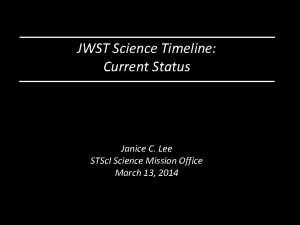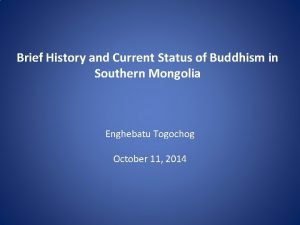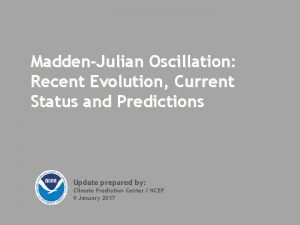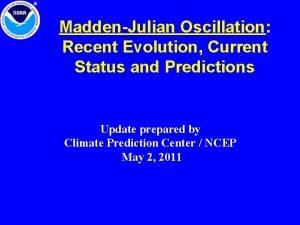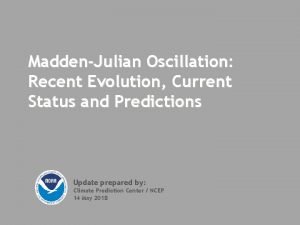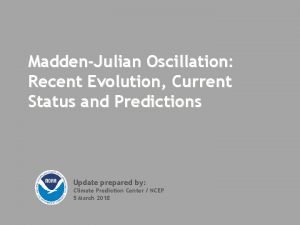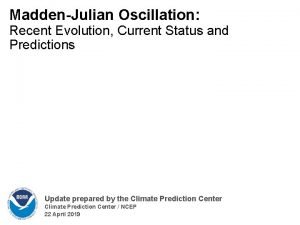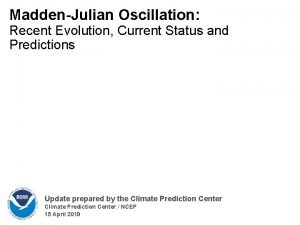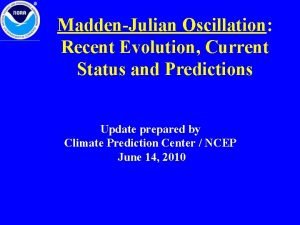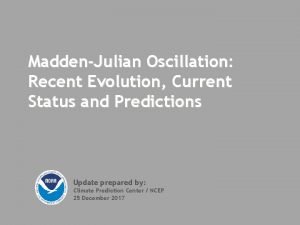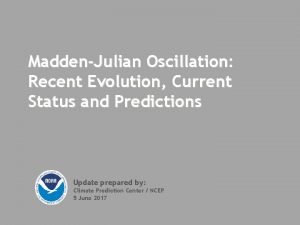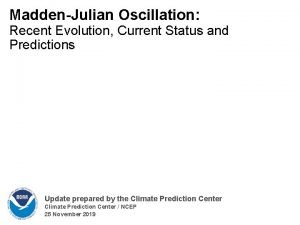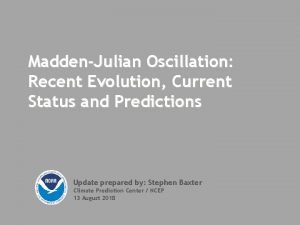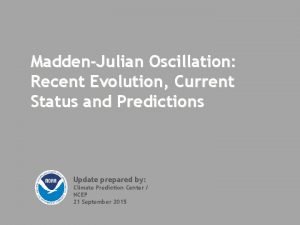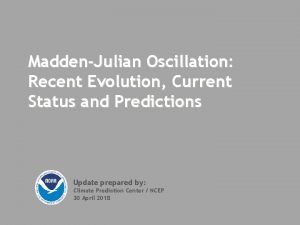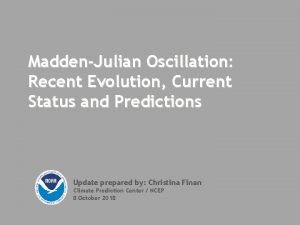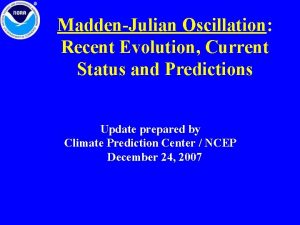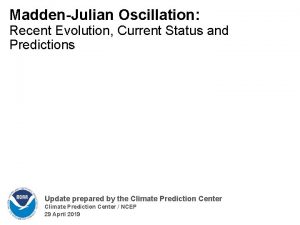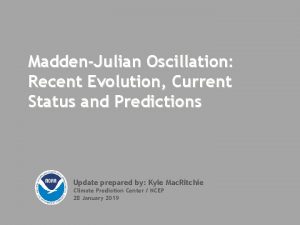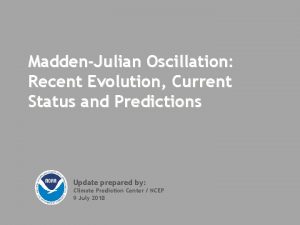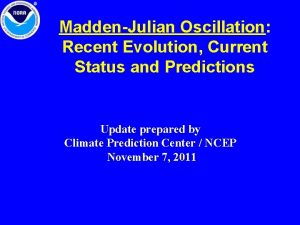MaddenJulian Oscillation Recent Evolution Current Status and Predictions





















- Slides: 21

Madden-Julian Oscillation: Recent Evolution, Current Status and Predictions Update prepared by Climate Prediction Center / NCEP August 12, 2013

Outline • Overview • Recent Evolution and Current Conditions • MJO Index Information • MJO Index Forecasts • MJO Composites

Overview • The MJO signal remained weak during the past week. The influence of other modes of variability is dominating the global tropical circulation. • Most dynamical and statistical model MJO forecasts indicate a weak or incoherent MJO pattern during Week-1, with some indication of a weak MJO signal emerging over the Western Hemisphere during Week-2. • Based on recent observations and statistical forecasts, the MJO is not forecast to play a major role in the atmospheric circulation during the next two weeks, though some impacts are possible during Week-2. • Enhanced convection is favored over the Maritime Continent and Southeast Asia during the next one to two weeks, while suppressed convection is expected over parts of India, the equatorial Indian Ocean, and the western Pacific. • Odds of tropical cyclone formation are enhanced across parts of the western North Pacific during Week-1, mainly north of 20 N. Elevated odds for tropical cyclone development are expected across parts of the East Pacific and Atlantic Basins during Week-2. Additional potential impacts across the global tropics and a discussion for the U. S. are available at: http: //www. cpc. ncep. noaa. gov/products/precip/CWlink/ghazards/index. php

850 -h. Pa Vector Wind Anomalies (m s-1) Note that shading denotes the zonal wind anomaly Blue shades: Easterly anomalies Red shades: Westerly anomalies The Indian monsoonal circulation weakened over the past several days. Westerly (easterly) anomalies have persisted over the Maritime Continent (western Pacific). Westerly anomalies persisted (strengthened) across the eastern Atlantic Ocean (East Pacific).

850 -h. Pa Zonal Wind Anomalies (m s-1) Westerly anomalies (orange/red shading) represent anomalous west-to-east flow Easterly anomalies (blue shading) represent anomalous east-to-west flow During February, MJO activity was apparent in the low-level wind pattern (alternating dashed and dotted lines). During April, anomalies indicate signs of being influenced by equatorial Rossby wave activity with less eastward propagation evident. Time The MJO strengthened during early May, with the signal becoming more incoherent later in the month. The MJO strengthened again in late June, with eastward propagation of low-level westerly wind anomalies noted. The propagation speed was at the faster end of the spectrum. Longitude During late July and early August, other modes contributed to the tropical circulation, with some westward moving modes and faster Kelvin waves evident.

OLR Anomalies – Past 30 days Drier-than-normal conditions, positive OLR anomalies (yellow/red shading) Wetter-than-normal conditions, negative OLR anomalies (blue shading) During mid-July, the MJO enhanced phase propagated over the Indian Ocean to the Maritime Continent, promoting increased convection. The MJO signal weakened toward the end of the month. Enhanced convection shifted northeast across Southeast Asia and the Maritime Continent. Enhanced (suppressed) convection continued across the North American monsoon region (central Pacific). During late July and early August, other modes of variability influenced anomalous convection with enhanced convection persisting across Southeast Asia and the Maritime Continent. Drier conditions are noted across Mexico and the Caribbean region.

Outgoing Longwave Radiation (OLR) Anomalies (2. 5°N-17. 5°N) Drier-than-normal conditions, positive OLR anomalies (yellow/red shading) Wetter-than-normal conditions, negative OLR anomalies (blue shading) (Courtesy of CAWCR Australia Bureau of Meteorology) The MJO was a dominant mode of variability across the Tropics from February to March as indicated by the alternating dashed and dotted lines. Time Near the end of March, the anomalies show signs of influence from other modes of tropical variability. However, MJO activity reemerged in early April across the Indian Ocean, then again in early May. Each time, the MJO signal quickly broke down. The MJO signal emerged during June and continued to July, as indicated by the alternating dashed and dotted lines. Other modes of variability have dominated more recently, such as a Rossby wave over the Maritime continent and a Kelvin Wave over the eastern Pacific. Longitude

200 -h. Pa Velocity Potential Anomalies (5°S-5°N) Positive anomalies (brown shading) indicate unfavorable conditions for precipitation Negative anomalies (green shading) indicate favorable conditions for precipitation A MJO signal is evident in late February and early March. Anomalies increased in magnitude with more robust eastward propagation indicated during April 2013. Time The velocity potential anomalies were more coherent only briefly during early to mid-May. During late June and the first half of July, the signal was more coherent and consistent with a canonical MJO footprint. More recently, a more stationary pattern is noted along with evidence of atmospheric Kelvin waves. Longitude

IR Temperatures (K) / 200 -h. Pa Velocity Potential Anomalies Positive anomalies (brown contours) indicate unfavorable conditions for precipitation Negative anomalies (green contours) indicate favorable conditions for precipitation The velocity potential pattern indicates upper-level divergence persisting across the Maritime Continent while upper-level convergence dominates across Africa and parts of the central Pacific. Tropical activity is noted across the east Pacific.

200 -h. Pa Vector Wind Anomalies (m s-1) Note that shading denotes the zonal wind anomaly Blue shades: Easterly anomalies Red shades: Westerly anomalies Westerly wind anomalies continue across much of the Tropics.

200 -h. Pa Zonal Wind Anomalies (m s-1) Westerly anomalies (orange/red shading) represent anomalous west-toeast flow Easterly anomalies (blue shading) represent anomalous east-to-west flow Eastward propagation of westerly wind anomalies associated with the MJO continued into April 2013. Some propagation of easterly anomalies is evident during late January and early February. Time During March and early April, anomalies were influenced by westward moving features over the central and western Pacific. During June and early July, eastward propagation of upper-level zonal wind anomalies was observed. More recently, influence from other modes of tropical intraseasonal variability produced a less coherent upper-level zonal wind anomaly pattern. Longitude

Weekly Heat Content Evolution in the Equatorial Pacific Through August 2012, heat content anomalies became positive and increased in magnitude across the eastern equatorial Pacific, partly in association with a downwelling Kelvin wave. An oceanic Kelvin wave was initiated at the end of September and increased heat content across the central and eastern Pacific during October and November. Time Positive (negative) anomalies developed in the western (eastern) Pacific during January 2013 and persisted into early March. The influence of a downwelling oceanic Kelvin wave can be seen during late February and March as anomalies became positive in the east-central Pacific. Positive anomalies increased over the central Pacific during June and July 2013. Longitude

MJO Index -- Information • The MJO index illustrated on the next several slides is the CPC version of the Wheeler and Hendon index (2004, hereafter WH 2004). Wheeler M. and H. Hendon, 2004: An All-Season Real-Time Multivariate MJO Index: Development of an Index for Monitoring and Prediction, Monthly Weather Review, 132, 1917 -1932. • The methodology is very similar to that described in WH 2004 but does not include the linear removal of ENSO variability associated with a sea surface temperature index. The methodology is consistent with that outlined by the U. S. CLIVAR MJO Working Group. Gottschalck et al. 2010: A Framework for Assessing Operational Madden-Julian Oscillation Forecasts: A CLIVAR MJO Working Group Project, Bull. Amer. Met. Soc. , 91, 1247 -1258. • The index is based on a combined Empirical Orthogonal Function (EOF) analysis using fields of near-equatorially-averaged 850 -h. Pa and 200 -h. Pa zonal wind and outgoing longwave radiation (OLR).

MJO Index -- Recent Evolution § The axes (RMM 1 and RMM 2) represent daily values of the principal components from the two leading modes § The triangular areas indicate the location of the enhanced phase of the MJO § Counter-clockwise motion is indicative of eastward propagation. Large dot most recent observation. § Distance from the origin is proportional to MJO strength § Line colors distinguish different months During the previous week, the Wheeler-Hendon Index indicated a weak MJO signal.

MJO Index – Historical Daily Time Series Time series of daily MJO index amplitude from 1997 to present. Plots put current MJO activity in historical context.

Ensemble GFS (GEFS) MJO Forecast Yellow Lines – 20 Individual Members Green Line – Ensemble Mean RMM 1 and RMM 2 values for the most recent 40 days and forecasts from the ensemble Global Forecast System (GEFS) for the next 15 days light gray shading: 90% of forecasts dark gray shading: 50% of forecasts The ensemble GFS indicates an incoherent MJO signal during Week-1, with a weak signal emerging near Phase 8 in Week-2.

Ensemble Mean GFS MJO Forecast Figures below show MJO associated OLR anomalies only (reconstructed from RMM 1 and RMM 2) and do not include contributions from other modes (i. e. , ENSO, monsoons, etc. ) Spatial map of OLR anomalies for the next 15 days The ensemble mean GFS forecasts little to no anomalous convection during the next 10 days. Time-longitude section of (7. 5°S-7. 5°N) OLR anomalies for the last 180 days and for the next 15 days

Constructed Analog (CA) MJO Forecast Figure below shows MJO associated OLR anomalies only (reconstructed from RMM 1 and RMM 2) and do not include contributions from other modes (i. e. , ENSO, monsoons, etc. ) Spatial map of OLR anomalies for the next 15 days This statistical forecast indicates little to no anomalous convection during the next two weeks. Time-longitude section of (7. 5°S-7. 5°N) OLR anomalies for the last 180 days and for the next 15 days

MJO Composites – Global Tropics 850 -h. Pa Velocity Potential and Wind Anomalies (May-Sep) Precipitation Anomalies (May-Sep)

U. S. MJO Composites – Temperature § Left hand side plots show temperature anomalies by MJO phase for MJO events that have occurred over the three month period in the historical record. Blue (orange) shades show negative (positive) anomalies respectively. § Right hand side plots show a measure of significance for the left hand side anomalies. Purple shades indicate areas in which the anomalies are significant at the 95% or better confidence level. Zhou et al. (2011): A composite study of the MJO influence on the surface air temperature and precipitation over the Continental United States, Climate Dynamics, 1 -13, doi: 10. 1007/s 00382 -0111001 -9 http: //www. cpc. ncep. noaa. gov/products/precip/CWlink/MJO/mjo. shtml

U. S. MJO Composites – Precipitation § Left hand side plots show precipitation anomalies by MJO phase for MJO events that have occurred over the three month period in the historical record. Brown (green) shades show negative (positive) anomalies respectively. § Right hand side plots show a measure of significance for the left hand side anomalies. Purple shades indicate areas in which the anomalies are significant at the 95% or better confidence level. Zhou et al. (2011): A composite study of the MJO influence on the surface air temperature and precipitation over the Continental United States, Climate Dynamics, 1 -13, doi: 10. 1007/s 00382 -0111001 -9 http: //www. cpc. ncep. noaa. gov/products/precip/CWlink/MJO/mjo. shtml
 Y connected generator
Y connected generator Difference between phase voltage and line voltage
Difference between phase voltage and line voltage Semiconductor
Semiconductor Ac theory 3 lesson 4
Ac theory 3 lesson 4 Drift current
Drift current Ceramic composition resistors
Ceramic composition resistors Wye delta diagram
Wye delta diagram Slideplayer
Slideplayer Diffusion current formula
Diffusion current formula Different method of size separation or
Different method of size separation or The constant current region of a jfet lies between
The constant current region of a jfet lies between In alternators the welding current is produced on the ____.
In alternators the welding current is produced on the ____. Touch current vs leakage current
Touch current vs leakage current Kcl mesh analysis
Kcl mesh analysis Current program status register is
Current program status register is Timeline jwst
Timeline jwst Current status of buddhism
Current status of buddhism Restoring force definition
Restoring force definition Non-thrust oscillation techniques
Non-thrust oscillation techniques Non-thrust oscillation techniques
Non-thrust oscillation techniques What is the amplitude of the oscillation
What is the amplitude of the oscillation Mobilization grades
Mobilization grades















